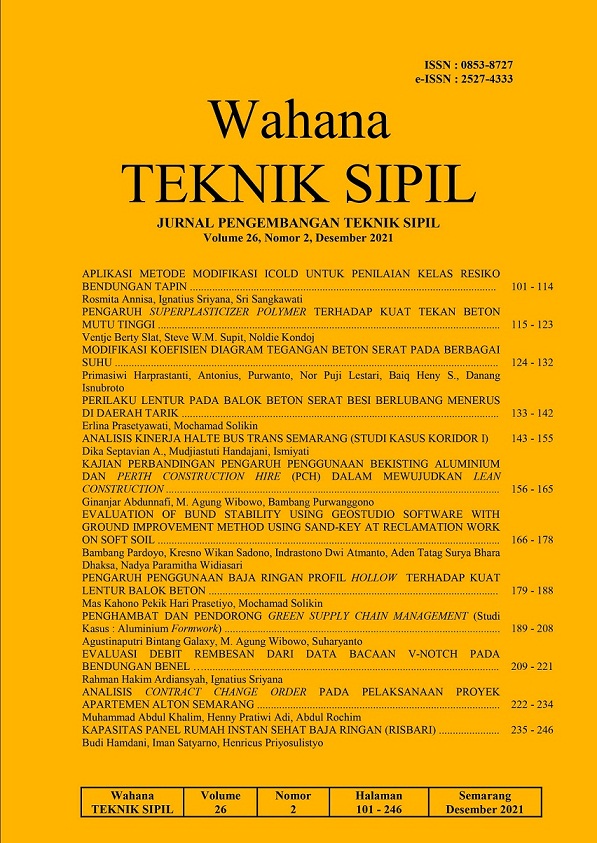PERILAKU LENTUR PADA BALOK BETON SERAT BESI BERLUBANG MENERUS DI DAERAH TARIK
DOI:
https://doi.org/10.32497/wahanats.v26i2.3128Keywords:
fiber block with holes, tensile areaAbstract
Concrete beams that receive a positive bending force, at the top will experience a compressive force while at the bottom receive a tensile force. The theory that reinforced concrete is a structural system where the steel or reinforcement in the concrete functions to withstand tension, then the concrete below the neutral line does not receive a compressive force but transmits a tensile force to the reinforcement. This study analyzes and reduces the area in the tensile area by continuously installing 2 inch diameter PVC pipes and adding fiber to the concrete. This reduction in area is expected to reduce weight and material savings without reducing its strength. This research was carried out with a sample of 28 days old concrete blocks with quality f'c = 21.04 MPa with dimensions of 12 cm x 18 cm x 250 cm, with 4Ø10 mm reinforcement with quality fy = 450 MPa. Concrete beams are made in 3 variations in the form of solid beams, hollow beams without fiber, hollow beams with fiber. Each variation has 2 samples. From the test results, all beams experienced flexural cracks which were characterized by cracks perpendicular to the beam axis and flexural strength behavior which the difference was not significant. From the three variations of this beam, it shows that the results of the hollow beam with the addition of fiber have a greater first crack load. The addition of fiber is able to slow down the cracks that occur and contribute to withstand tensile stresses so that the beam still has strength to bear the load even though cracks have occurred. Based on the calculation simulation, in order to equalize the strength of the hollow beam with fiber, the dimensions of the solid beam need to be enlarged so that the solid beam becomes more expensive. This shows that hollow beams with fiber are more economical than solid beams.References
Al-Ghasam, T., 2015, Reinforced Concrete Moderate Deep Beams with Embedded PVC Pipes. Wasit Journal Of Engineering Sciences 3(1): 19-29.
Asroni, A., 2017, Teori dan Desain Balok Plat Beton Bertulang Berdasarkan SNI 2847-2013. Muhammadiyah University Press.
DPU, 1988, Modul Pengantar Dan Prinsip-Prinsip Perencanaan Bangunan Bawah / Pondasi Jembatan.
Balagi, G., and Vetturarasudharsanan R., 2019, Experimental Investigation on Flexural Behaviour of RC Hollow Beams. In Materials Today: Proceedings 21, Elsevier, 1-6.
Hassan, N.Z., Hala M. I. and Salman, A.M., 2018, Study Behaviour of Hollow Reinforced Concrete Beam, International Journal of Current Engineering and Technology 8(6): 1640-51.
Mulyono, T., 2004, Teknologi Beton. Yogjakarta: Andi Offset.
Nawy. E.G., 2003, Reinforced Concrete A Fundamental Approach, Fifth Edition, New Jersey: Prentice Hall International.
PUPR, 2005, Puslitbang Prasarana Transportasi, Divisi 7-2005.
Rizky. P.F., Sugeng. P.B. dan Wijaya, M.N., 2016, Analisa Kekakuan Struktur Balok Beton Berlubang dengan Lubang Hollow Core Pada Tengah Balok, Journal Artikel Mahasiswa Teknik Sipil 1(2): 1-11.
SNI., 2002, Tata Cara Perhitungan Struktur Beton Untuk Bangunan Gedung, SNI 03-2847-2002.
SNI., 2011, Cara Uji Kuat Tekan Beton Dengan Benda Uji Silinder, SNI 1974 ”“ 2011.
Soroushian, P., and Bayazi Z., 1987, Concept of Fiber Reinforced Concrete. In Proceeding of The International Seminar On Fiber Reinforced Concrete, Michigan: Michigan State University.
Tjokrodimuljo, K., 1996, Teknologi Beton Yogjakarta, Universitas Gadjah Mada.
Downloads
Published
Issue
Section
License
Authors who publish with this journal agree to the following terms:Authors retain copyright and grant the journal right of first publication with the work simultaneously licensed under a Creative Commons Attribution License that allows others to share the work with an acknowledgement of the work's authorship and initial publication in this journal.
Authors are able to enter into separate, additional contractual arrangements for the non-exclusive distribution of the journal's published version of the work (e.g., post it to an institutional repository or publish it in a book), with an acknowledgement of its initial publication in this journal.
Authors are permitted and encouraged to post their work online (e.g., in institutional repositories or on their website) prior to and during the submission process, as it can lead to productive exchanges, as well as earlier and greater citation of published work (See The Effect of Open Access).






